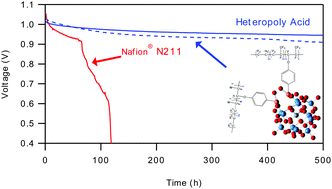Heteropoly acid functionalized fluoroelastomer with outstanding chemical durability and performance for vehicular fuel cells†
Abstract
To further facilitate commercialization of automotive fuel cells, durability concerns need to be addressed. Currently the addition of a mechanical support in the membrane is able to adequately solve issues of mechanical degradation, but chemical degradation via oxygenated radical attack remains an unsolved challenge. Typical mitigation strategies use cerium or manganese species to serve as radical scavengers, but these ions are able to migrate in the membrane and even leach out of the system. The approach used in this study is to covalently link and immobilize a heteropoly acid (HPA), more specifically 11-silicotungstic acid (HSiW11), a lacunary HPA of the Keggin structure to a fluoroelastomer, serving as both a radical decomposition catalyst and the proton conducting acid. This dual functionality allows for both high content of radical scavenging species and high ion-exchange capacity. An efficient three step, high yield (77%), commercially viable synthesis for this polymer is reported. The synthesis route for making this new heteropoly acid functionalized polymer is confirmed using infrared spectroscopy (IR), nuclear magnetic resonance (NMR) spectroscopy, and thermogravimetric analysis (TGA). The material exhibits clustering of the HSiW11 moieties, resulting in a poorly connected proton conducting phase when dry, but excellent conductivity is achieved at elevated humidities (0.298 S cm−1 at 80 °C and 95% RH). The proton conductivity shows an enhancement above 60 °C due to a softening of the polymer, as shown by DSC. Under an aggressive chemical accelerated stress test (AST), 90 °C, 30% RH, zero current, and pure O2, the PolyHPA losses only 0.05 V of open circuit voltage (OCV) after 500 h, greatly out performing any other material reported in the literature. For comparison, the Nafion® N211 fuel cell drops below 0.8 V after only 76 h under the same conditions. In fuel cell testing the PolyHPAs have outstanding chemical stability and also possess very low in situ high frequency resistance (HFR) leading to high performance (1.14 W cm−2 at 2 A cm−2), compared to 1.11 W cm−2 for the Nafion® N211 fuel cell at the same current. At 75 wt% HSiW11 loading, the fuel cell HFR showed a 22% decrease over N211.



 Please wait while we load your content...
Please wait while we load your content...
